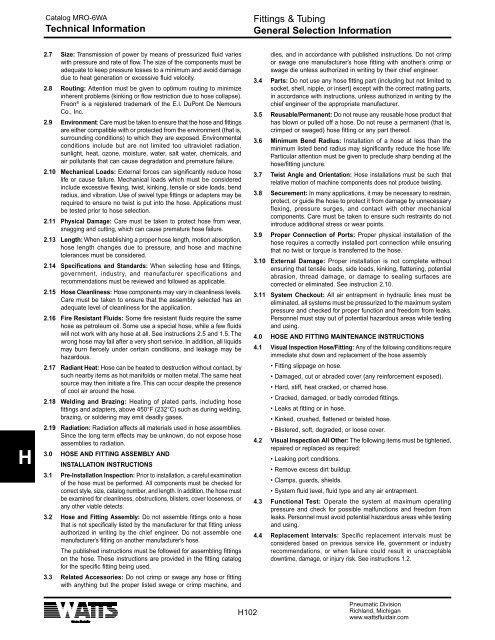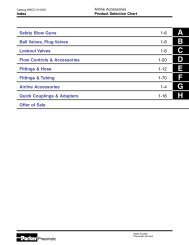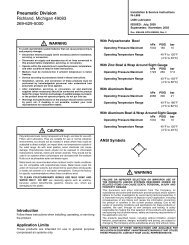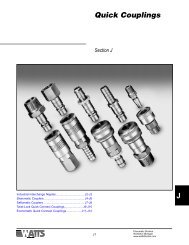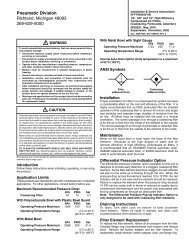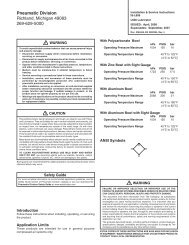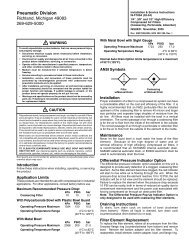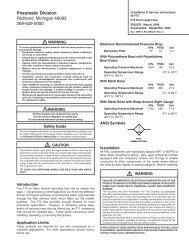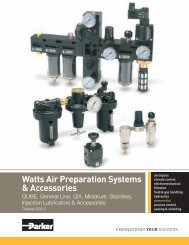Specification - Watts Fluid Air
Specification - Watts Fluid Air
Specification - Watts Fluid Air
Create successful ePaper yourself
Turn your PDF publications into a flip-book with our unique Google optimized e-Paper software.
Catalog MRO-6WATechnical InformationFittings & TubingGeneral Selection InformationH2.7 Size: Transmission of power by means of pressurized fluid varieswith pressure and rate of flow. The size of the components must beadequate to keep pressure losses to a minimum and avoid damagedue to heat generation or excessive fluid velocity.2.8 Routing: Attention must be given to optimum routing to minimizeinherent problems (kinking or flow restriction due to hose collapse).Freon ® is a registered trademark of the E.l. DuPont De NemoursCo., Inc.2.9 Environment: Care must be taken to ensure that the hose and fittingsare either compatible with or protected from the environment (that is,surrounding conditions) to which they are exposed. Environmentalconditions include but are not limited too ultraviolet radiation,sunlight, heat, ozone, moisture, water, salt water, chemicals, andair pollutants that can cause degradation and premature failure.2.10 Mechanical Loads: External forces can significantly reduce hoselife or cause failure. Mechanical loads which must be consideredinclude excessive flexing, twist, kinking, tensile or side loads, bendradius, and vibration. Use of swivel type fittings or adapters may berequired to ensure no twist is put into the hose. Applications mustbe tested prior to hose selection.2.11 Physical Damage: Care must be taken to protect hose from wear,snagging and cutting, which can cause premature hose failure.2.13 Length: When establishing a proper hose length, motion absorption,hose length changes due to pressure, and hose and machinetolerances must be considered.2.14 <strong>Specification</strong>s and Standards: When selecting hose and fittings,government, industry, and manufacturer specifications andrecommendations must be reviewed and followed as applicable.2.15 Hose Cleanliness: Hose components may vary in cleanliness levels.Care must be taken to ensure that the assembly selected has anadequate level of cleanliness for the application.2.16 Fire Resistant <strong>Fluid</strong>s: Some fire resistant fluids require the samehose as petroleum oil. Some use a special hose, while a few fluidswill not work with any hose at all. See instructions 2.5 and 1.5. Thewrong hose may fail after a very short service. In addition, all liquidsmay burn fiercely under certain conditions, and leakage may behazardous.2.17 Radiant Heat: Hose can be heated to destruction without contact, bysuch nearby items as hot manifolds or molten metal. The same heatsource may then initiate a fire. This can occur despite the presenceof cool air around the hose.2.18 Welding and Brazing: Heating of plated parts, including hosefittings and adapters, above 450°F (232°C) such as during welding,brazing, or soldering may emit deadly gases.2.19 Radiation: Radiation affects all materials used in hose assemblies.Since the long term effects may be unknown, do not expose hoseassemblies to radiation.3.0 HOSE AND FITTING ASSEMBLY ANDINSTALLATION INSTRUCTIONS3.1 Pre‐lnstallatlon Inspection: Prior to installation, a careful examinationof the hose must be performed. All components must be checked forcorrect style, size, catalog number, and length. In addition, the hose mustbe examined for cleanliness, obstructions, blisters, cover looseness, orany other viable detects.3.2 Hose and Fitting Assembly: Do not assemble fittings onto a hosethat is not specifically listed by the manufacturer for that fitting unlessauthorized in writing by the chief engineer. Do not assemble onemanufacturer’s fitting on another manufacturer’s hose.The published instructions must be followed for assembling fittingson the hose. These instructions are provided in the fitting catalogfor the specific fitting being used.3.3 Related Accessories: Do not crimp or swage any hose or fittingwith anything but the proper listed swage or crimp machine, anddies, and in accordance with published instructions. Do not crimpor swage one manufacturer’s hose fitting with another’s crimp orswage die unless authorized in writing by their chief engineer.3.4 Parts: Do not use any hose fitting part (including but not limited tosocket, shell, nipple, or insert) except with the correct mating parts,in accordance with instructions, unless authorized in writing by thechief engineer of the appropriate manufacturer.3.5 Reusable/Permanent: Do not reuse any reusable hose product thathas blown or pulled off a hose. Do not reuse a permanent (that is,crimped or swaged) hose fitting or any part thereof.3.6 Minimum Bend Radius: Installation of a hose at less than theminimum listed bend radius may significantly reduce the hose life.Particular attention must be given to preclude sharp bending at thehose/fitting juncture.3.7 Twist Angle and Orientation: Hose installations must be such thatrelative motion of machine components does not produce twisting.3.8 Securement: In many applications, it may be necessary to restrain,protect, or guide the hose to protect it from damage by unnecessaryflexing, pressure surges, and contact with other mechanicalcomponents. Care must be taken to ensure such restraints do notintroduce additional stress or wear points.3.9 Proper Connection of Ports: Proper physical installation of thehose requires a correctly installed port connection while ensuringthat no twist or torque is transferred to the hose.3.10 External Damage: Proper installation is not complete withoutensuring that tensile loads, side loads, kinking, flattening, potentialabrasion, thread damage, or damage to sealing surfaces arecorrected or eliminated. See instruction 2.10.3.11 System Checkout: All air entrapment in hydraulic lines must beeliminated, all systems must be pressurized to the maximum systempressure and checked for proper function and freedom from leaks.Personnel must stay out of potential hazardous areas while testingand using.4.0 HOSE AND FITTING MAINTENANCE INSTRUCTIONS4.1 Visual Inspection Hose/Fitting: Any of the following conditions requireimmediate shut down and replacement of the hose assembly• Fitting slippage on hose.• Damaged, cut or abraded cover (any reinforcement exposed).• Hard, stiff, heat cracked, or charred hose.• Cracked, damaged, or badly corroded fittings.• Leaks at fitting or in hose.• Kinked, crushed, flattened or twisted hose.• Blistered, soft, degraded, or loose cover.4.2 Visual Inspection All Other: The following items must be tightened,repaired or replaced as required:• Leaking port conditions.• Remove excess dirt buildup.• Clamps, guards, shields.• System fluid level, fluid type and any air entrapment.4.3 Functional Test: Operate the system at maximum operatingpressure and check for possible malfunctions and freedom fromleaks. Personnel must avoid potential hazardous areas while testingand using.4.4 Replacement Intervals: Specific replacement intervals must beconsidered based on previous service life, government or industryrecommendations, or when failure could result in unacceptabledowntime, damage, or injury risk. See instructions 1.2.H102Pneumatic DivisionRichland, Michiganwww.wattsfluidair.com


